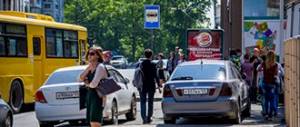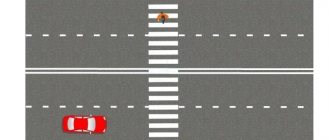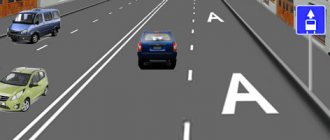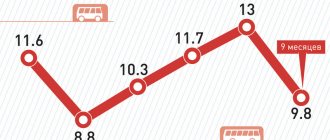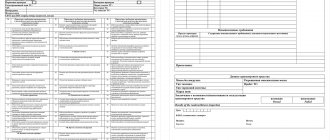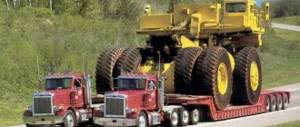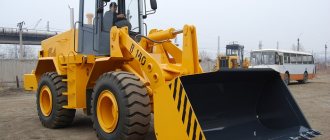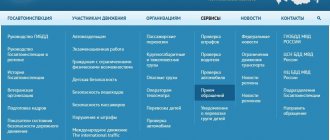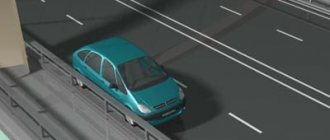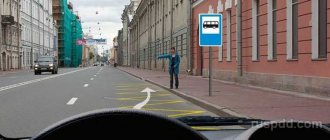The sign prohibiting stopping the car is one of the unloved signs and many people prefer to simply not notice it. The result is a dissatisfied inspector, a report and a fine. But why break the rules and make life difficult for yourself? A competent motorist knows in which places stopping is prohibited and how, remembering the rules, to get out of the situation without penalties. Most often, the cause of misunderstandings and fines is citizen’s ignorance of the rules, as well as the concepts themselves. A huge number of people simply do not understand the difference between stopping, parking and parking.
Have you ever needed the help of a car lawyer?
Not really
Parking in front of the intersection according to traffic rules
Traffic regulations requirements for parking a vehicle are the same both in relation to an intersection and in other cases. The main ones:
- You can only park your vehicle on the side of the road on the right. If there is no shoulder, the car is placed as close to the edge as possible so as not to interfere with other road users.
- Opposite parking is only permitted on single-lane roads, without a tram line in the middle and on one-way roads.
- Vehicles are placed exclusively in one row; two-wheeled vehicles without a trailer can be placed in two rows.
- Outside populated areas, long stops are permitted only at special sites (exceptions include the presence of a wide shoulder or a vehicle breakdown).
The method of parking and stopping, including at intersections, is regulated by sign 6.4, information signs 8.6.4–8.6.9 and road markings.
Mandatory standards
The minimum permissible distance from a parked car to the beginning of the intersection of roadways is 5 meters. This standard is contained in clause 12.4 of the traffic rules. According to it, it is prohibited to stop a car not only closer than the established distance to the intersection, but also at pedestrian crossings located on it.
The boundaries of an intersection can be determined by the nearest point of intersection of roadways. In most cases, it is located on the outer corner of the intersection, at the point where the edge of the roadway begins to round off. If there are any doubts about determining the five-meter distance “by eye”, then it is better to play it safe and park the car further away. The traffic police inspector will definitely have a tape measure or other means of change and it is better to take care of “spare” centimeters or meters in advance.
Stopping on overpasses, bridges, overpasses and under them is prohibited
This ban immediately provides an exception if stopping is allowed in a given direction for more than three lanes. The exception applies only when located on these objects. Stopping under overpasses and overpasses is prohibited.
As in previous cases, the traffic rules do not clearly define the boundaries of these road structures. They may be determined differently in each case by each inspector and each judge. Some along the sign with the name of the river, some along the fences of bridges, some at the beginning of the ascent, and so on.
Where you can and cannot stop
The current Traffic Rules contain many nuances related to the place where a vehicle stops and parks near an intersection.
Before the stop line
If there is a stop line drawn on the asphalt or indicated by a sign at the intersection of roadways, the driver is obliged to stop his vehicle no closer than 5 meters from it. It is this marking that indicates the beginning of the intersection.
The stop line can be indicated:
- only by markings on the asphalt;
- only sign 6.16;
- together with the 6.16 sign and markings on the asphalt.
In the latter case, the counting of five meters should begin from the sign, since it is this sign that has priority over the road markings.
If a signalized intersection without a stop line
The absence of a stop line makes it somewhat difficult to choose a parking spot. In this case, the following circumstances should be taken into account:
- At the intersection there is a marked zebra crossing or a sign indicating a pedestrian crossing. The distance of 5 meters in this case is calculated from these symbols and markings.
- There is no pedestrian crossing at the intersection. It is necessary to measure the minimum permissible gap from the nearest point of intersection of roadways (most often this is the outer corner of the intersection or the beginning of a rounding).
In both cases, it is not allowed to stop a vehicle behind an established traffic light or directly in front of it. Since such placement of the car blocks the view of other drivers, and also creates the likelihood of a traffic jam.
Prohibited stopping places
It is prohibited to stop a vehicle near intersections if:
- There is a distance of less than 3 meters between the car and the opposite edge of the road, a continuous marking line (except for those indicating the side of the road) or a dividing strip. This rule is the same for all sections of the road (even without intersections) and is designed to eliminate the creation of possible obstacles and congestion on the roadway;
- The stopping place is located directly on the pedestrian crossing markings or closer than 5 meters to it. Thus, the place where pedestrians cross the roadway remains clearly visible, and other motorists see the person on it in advance. An important nuance - immediately after the pedestrian crossing, parking is permitted provided that the car is located in its own lane, without changing the direction of movement. The 5 meter rule does not apply in this case. You can drive through a pedestrian crossing and intersection and safely park your car.
In what places should you not leave your car for a long time?
Traffic rules provide for two concepts:
- A stop is a short-term cessation of movement, lasting no more than 5 minutes. In this case, the driver can drop off passengers or unload luggage from the car without leaving the car for a long time. The rules for stopping briefly near intersections are described above.
- Parking is a cessation of movement for a long period of time (more than 5 minutes). The reasons for parking can be very different; there is no exact list of them in the traffic rules. An exception is a vehicle breakdown; such a situation is not considered parking.
Leaving the car for a long time or, in other words, parking near an intersection is prohibited under the same conditions when stopping is prohibited: closer than 5 meters to a zebra crossing, in the presence of a prohibitory sign and when the roadway is insufficiently wide. In addition, other rules must not be violated, regardless of the proximity of the intersection of roadways:
- It is prohibited to park on lawns and sidewalks;
- It is not allowed to park a vehicle at a distance closer than 50 meters from a railway crossing or when the view is reduced and interferes with other traffic participants;
- Parking is not permitted on highways, except at specially designated rest areas. It is prohibited to park a vehicle on the edge of a roadway located outside populated areas. In this case, only the curb is used for parking.
Penalties for illegal stopping and parking
For violations of parking/stopping rules, the Code of Administrative Offenses (hereinafter referred to as the Code of Administrative Offenses of the Russian Federation) provides for two main penalties: a fine and detention of the vehicle.
Fine
The Code of Administrative Offenses of the Russian Federation contains quite a few fines for non-compliance with Chapter 12 of the Traffic Regulations “Stopping and Parking”. They concern various violations in this area. The fine for stopping near the sign, i.e. in the prohibited zone, is prescribed in Article 12.16 of the Code of Administrative Offenses of the Russian Federation. It is equal to 1,500 rubles for all of Russia and 3,000 rubles for Moscow and St. Petersburg.
For other violations of parking/stopping rules, the state has established the following fines (and sometimes in addition other penalties):
- for stopping on a lane for fixed-route transport - 1,500 rubles, for Moscow and St. Petersburg - 3,000 rubles;
- for stopping/parking at a pedestrian crossing - 1000 rubles, in Moscow and St. Petersburg - 3000 rubles;
- for stopping/parking at a public transport stop - 1000 rubles, for Moscow and St. Petersburg - 3000 rubles;
- for stopping/parking on tram tracks - 1500 rubles, in Moscow and St. Petersburg - 3000 rubles;
- for stopping/parking on the roadway so that the car interferes with traffic - 2000 rubles, for Moscow and St. Petersburg - 3000 rubles;
- for stopping/parking at a railway crossing - 1000 rubles. or deprivation of a Sikh driver's license for six months;
- for stopping/parking in places for disabled people - 5,000 rubles;
- for violation of all other “minor” rules from Chapter 12 of the Traffic Regulations (for example, driving onto the sidewalk) - a warning or a fine of 500 rubles, in Moscow and St. Petersburg - 2500 rubles.
About all this - article 12.19 of the Code of Administrative Offenses of the Russian Federation.
Video: controversial situation with violation of parking rules
Discount on fine
If you hurry, you can pay not the entire fine, but only half of it. In the first 20 days after the resolution is drawn up and a fine is imposed, the violator has a 50% discount provided by law.
Car detention
If the car is parked under a prohibitory sign or in the zone of influence of such a sign, it can be taken to the impound lot (for a violation under Article 12.16 of the Administrative Code). But here you need to keep in mind: the fact that a tow truck is working should be warned by an additional information sign hanging under “OstZ” or “StoZ”.
You can take your car to the impound lot only if a special sign warns you about it.
In order to detain a car (that’s what this whole procedure with a tow truck is called), you need to draw up a protocol. Ideally, you should be present when it is compiled. But they can do this without you - they will record it on video or invite two witnesses. The protocol will indicate which rule you violated and will give you a punishment: a fine for illegal parking + detention of the car.
After the protocol, the car is taken away. How, when, who does this - these questions are answered by the laws of a specific region of the Russian Federation. That is, this process can occur differently everywhere. The main thing is that there is a protocol. There is no protocol - there is no reason to take the car.
But the return of the car is the same for all regions. The owner of the vehicle must pay a fine, which is issued along with the detention, the cost of transportation and maintaining the vehicle in the parking lot. After that he can take it away. At the impound lot, of course, you will need to show documents confirming that the car is yours or you have the right to drive it (for example, a compulsory motor liability insurance policy).
If you successfully managed to run while the car was just being processed for detention, and corrected your violation, for example, parked under a parking sign, and not under the “StoZ” sign, then the car will no longer be taken away. But before you fix it, you will need to confirm that the car is yours. Therefore, let the documents for the car always be with you, even if you left it for a short time.
A friend of mine left the car under a prohibitory sign. There was nowhere to park, and here, where he arrived, there was only half an hour to do. I decided that maybe it would pass. When the friend returned to the car, it had already been sealed and was about to be loaded onto a tow truck. The acquaintance, of course, ran up like a bullet: “Please don’t take it, I’m already leaving.” They ask him for documents confirming that the car is his. And the documents are in the car - my friend left for a while. Naturally, he didn’t show anything, and a sealed car cannot be opened without an inspector. (Cars are taken to the impound lot not by the State Traffic Safety Inspectorate, but by the Traffic Management Center, so there is no inspector during the arrest). And they took the swallow to the impound lot. On the same day, an acquaintance went to rescue the car. As you can imagine, the procedure became a little more complicated for him. I had to fill out a form stating that the car needed to be opened to remove documents. And after that, together with the inspector, open the car and take the documents. When everyone was convinced that my friend was the owner of the car, he paid the fine (with a 50 percent discount), transportation and maintenance of the car in the parking lot. Considering that the car did not sit there for even a day, the costs were relatively small (about 5,000 rubles: 3,000 rubles fine + other expenses). But the lesson was remembered for the rest of my life.
Penalties for violation of parking rules
For violating traffic rules and incorrectly choosing a place to stop or park a vehicle near the intersection, Parts 1 and 2 of Art. 12.12 of the Code of Administrative Offenses provides for punishment:
| Did not find an answer to your question? Call a lawyer! Moscow: +7 (499) 110-89-42 St. Petersburg: +7 (812) 385-56-34 Russia: +7 (499) 755-96-84 |
- Ignoring the requirements of road markings, in particular stopping in front of a stop line or a corresponding sign, is a fine of 800 rubles.
- When stopping at a controlled intersection (interpreted as driving through a prohibiting traffic light) - 1,000 rubles for the first violation and 5,000 rubles for a second violation. In addition, repeated violation of this rule will result in the deprivation of your driver's license for up to six months.
- Failure to comply with the minimum distance to an intersection will result in a fine of 500 rubles or a warning for a single violation.
If there is no sign prohibiting stopping or parking in the immediate vicinity of an intersection, this does not mean that it is possible to park your car in this place. It is also required to comply with other traffic regulations: minimum distance, avoidance of interfering with other drivers, the presence of nearby railway crossings, and so on.
It is prohibited to stop at pedestrian crossings and within 5 m in front of them
Since stopping is also allowed on the left oncoming side of the road, a situation arises that it would seem possible to stop on the left side after passing a pedestrian crossing. This interpretation is not correct. “Before the crosswalk” should be interpreted relative to the intended direction of travel in the lane, not the actual direction of the vehicle. This is both logical and safe.
Special cases of prohibition
Additional places where a motorist does not have the right to park a vehicle are the following places:
- near traffic lights and installed road signs in such a way that owners of cars passing by have the opportunity to see them;
- on paths intended for cyclists;
- in a place where the driver can close the entrance or exit from the yard, parking lot, local area, etc.
Important. When considering traffic rules in terms of places prohibited for parking, it is worth distinguishing between the concepts of parking and stopping. Parking is defined as the cessation of vehicle movement for more than 5 minutes, if it is not associated with loading or unloading things or boarding and disembarking passengers.
List of places subject to ban
The prohibition of parking at an intersection, the inability to stop a vehicle on a bridge section or in a tunnel - this is not a complete list of rules that apply not only on the territory of the Russian Federation, but also in most countries of the world. Compliance with them makes it possible to avoid accidents and other dangerous situations that lead to irreversible consequences and bring motorists to justice. The list of places where it is prohibited to leave or park vehicles is reflected in Part 12.4 of the Traffic Rules. Each individual subclause describes various cases in which the car owner cannot place the vehicle on a certain section of the highway.
Stopping on the territory of tram tracks or in the immediate vicinity of them is strictly prohibited, provided that such an action on the part of the motorist will interfere with traffic. In most cases, placing cars near them or on them is permitted, provided that such a period of the route is no longer used for the movement of such vehicles. Moreover, regardless of this factor, traffic police officers can issue a fine.
